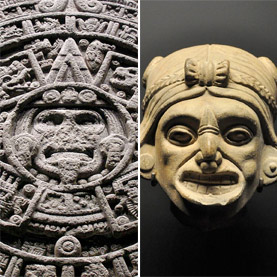
Neither the Maya Calendar–nor the World–Ends on December 21, 2012
for Scientific American
It’s a bright summer day at the National Museum of Anthropology in Mexico City. Outside, in the sprawling front plaza rimmed by palm and willow trees, young couples cuddle by the steps, vendors sell wrestling masks and tacos, and five men dressed in traditional Totonac garb slowly spin upside down in the death defying “Dance of the Flyers” for the tourists.
Inside the museum is a wonder of culture and history. Each wing is dedicated to a separate civilization in Mesoamerican culture—one for the Toltecs, another for Teotihuacan. But the largest spaces are reserved for the Aztecs and Maya. And in the center of the building is the stunning Aztec Stone of the Sun—often erroneously called the “Aztec Calendar”—perhaps the most recognizable symbol in Latin America. Diana Magaloni Kerpel, the museum director, peers at the stone.
“It is not a calendar. It’s really the image of space and time. It’s an image of how the Aztecs conceived themselves as in the center of time and space,” she says. “Look at that. There is face in the middle—that is the cosmos. The Maya wouldn’t do that—ever.”
If you have not been paying attention to doomsayers or John Cusack movies, December 21, 2012, is the day that many say the Maya predicted the world would end. Internet stories regularly detail the Maya calendars although displaying the Aztec Stone of the Sun (including one, we regret, that was published on Scientific American Online). Looking at the reality of ancient Mesoamerica, it quickly becomes clear that much of the uproar rose out of a confusion of two distinct cultures that lived 500 years apart.
“There’s a lot of conflation between these two cultures. It would almost be like comparing England at the time of the War of the Roses to the Romans or the Romans to the Greeks in the age of Pericles,” says Stephen Houston, a Mayanist at Brown University. “They are vastly different periods, separated by considerable distances. The societies had many shared features but they were organized in very different ways.”
To the average tourist, all the magnificent art here may blend together, and indeed they share many themes. But the Maya and Aztecs were very different cultures, analogous in many ways to the Greeks and Romans. Like the Greeks, the Maya were the older civilization to the east. Rather than a unified empire, they were more a collection of powerful city-states like Tikal and Calakmul, who occasionally fought each other. They also had highly realistic art and a form of mathematics far beyond that of ancient Europe.
The Aztecs (properly called the Mexica), on the other hand, ran a Romanesque, centrally organized empire with a powerful origin story for their all-powerful central city. They believed their people began in a mythical place to the north, called Aztlán. Like the Romans or the Jews before, they wandered through the wilderness, eventually reaching a giant lake in the mountains where they built Tenochtitlan—the largest city in the world at the time, now called Mexico City.
That was A.D. 1325, four centuries after the end of the great Maya era. The differences between the cultures can be seen in their art, politics and especially the way they perceived time.
Mexica mythology was full of wrath, death and enough cataclysmic destruction for a Hollywood movie. Their art evolved from highland people like the Toltecs through a tradition of sculpture. The Mexica regularly discussed the end of the world and sacrificed people to prevent it. Pieces like the Stone of the Sun or the Tlaltecuhtli monolith, discovered in 2006, were highly representational and filled with intimidating monsters. Tlaltecuhtli, the largest Mexica icon ever discovered, has claws, blood spurting from her mouth and skulls for knees. People were blocky with generic faces, almost like communist or nazi propaganda.